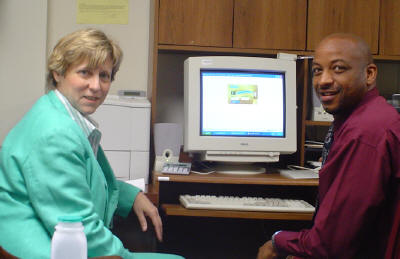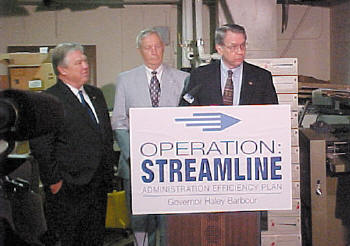 |
On hearing that neighboring Louisiana was using GIS to track fraud in the Food Stamp program, Taylor made a visit to see this system in action.He was so impressed that he immediately asked one of the article's authors, Bud Douglas, the Director of the Division of Management Information Services (MIS), to work with the staff in Louisiana to bring this technology to Mississippi.
The application was unusual in at least two ways.First, it focused on the locations of clients who receive Food Stamps and the stores that accept the Electronic Benefits Card (EBT), which operates like a debit card to deliver benefits.Second, a standard report writer, WebFOCUS from Information Builders, was used to sort and group the EBT transactions.An adapter was developed by the iWay subsidiary of Information Builders to integrate the information from the report with a map generated by ESRI's ArcIMS.Both WebFOCUS and ArcIMS deliver information within a standard web browser, the interface of choice at MDHS.
 |
Porting the application from Louisiana significantly reduced the cost to one-tenth of what Louisiana spent.These savings coincided with Taylor's goal of maximizing the use of funds and only implementing technology that would result in real dollar savings.Renee Hood, Director of Program Integrity, states that the investigators who just completed training on the application are excited and optimistic about the results they can achieve using information they can now obtain quickly and easily.
In a previous article in Directions Magazine, Mississippi: Proving Ground for the Location Aware Enterprise, the authors, Elizabeth Matlack (also one of the authors of this article) and Susan Kalweit, pointed out that Mississippi is positioned to be a leader in implementing GIS systems.A major reason is the fact that the state legislature established a Remote Sensing/GIS Coordinating Council (the Council) and a GIS Clearinghouse to encourage sharing of GIS data and applications among the various entities in the state.
In order to cooperate in this effort and to leverage maximum benefit from the work done in developing the GIS Fraud application, MDHS is working with the Council to expand the geocoded street address database required for the fraud application beyond the needs of MDHS.A committee formed by the Urban and Regional Information System Association (URISA) is working under the direction of the FGDC to establish national addressing standards (read more here). Both of the authors are on a committee to recommend a standard street addressing methodology to be adopted by the Council for the GIS Clearinghouse.The resulting statewide geocoded street address database would become part of the GIS Clearinghouse operated by the Department of Information Technology Services (ITS).ITS would host a service to accept street addresses from all entities, convert the address to the standard format and generate a geocoded address with a unique identification and a lat/long location.
 |
We credit the cooperation of ITS, under the leadership of David Litchliter, Executive Director, with minimizing the costs of implementation.ITS is hosting the ESRI software and the geocoded street address database, and considers this application as the "seed" application for the Clearinghouse.Douglas is chairman of a committee to recommend to the Council a standard for the geocoded street address database and is a member of the URISA National Addressing Standards Committee.
The major problem in creating a geocoded street address database in most states is the lack of accurate and up to date street centerlines and the inconsistent application of addressing standards across the state.Mississippi is no exception in this regard.In an effort to solve this problem, we are working to establish a pilot project plan that can be expanded to include all 82 counties in the state.The pilot plan calls for coordination and cooperation among various local entities that would ultimately benefit from the implementation. Included at the County level are the 911 coordinators, Firefighters Association, Emergency Management, Law Enforcement, the Tax Assessor, the Board of Supervisors, and the Planning and Development Districts.
The implementation would include the development of a "Graphical MSAG" to integrate the GIS database with the Master Street Address Guide (MSAG) used by 911 coordinators.This concept has been successfully implemented in Harris County, Texas, which includes the greater Houston area, by Marc Berryman, Director of GIS for the Greater Harris County 911 Emergency Network.A second successful implementation has been accomplished by Susan MacFarlane, Coordinator for the Maricopa County 911 Region in Arizona.This region includes Phoenix and adjacent Arizona communities.The benefits of a "Graphical MSAG" implementation include integration of the two databases, which enables one technical team to support both.The modifications that are provided by the telephone company in the form of address changes, additions and deletions of phone service will be fed through the MSAG interface.The GIS database will contain street addresses and will be updated as new developments evolve and will reflect changes in the existing street network.
In recognition of the fact that interoperability is a key to the success of any statewide project, the pilot will include an automated interface to the Automated System Project (ASP) for computer aided dispatch (CAD).The ASP project is under the direction of Major Julian Allen of the University of Southern Mississippi.The ASP project provides an integrated CAD for the three coastal counties of Mississippi.The CAD depends on current and accurate location information.This information will be provided with the implementation of the pilot county project being developed by Matlack and me.
An important byproduct of the county pilot will be a road map for implementation in other counties.The road map will included a description of the pilot, a list of key participants, costs estimates, hardware and software requirements, and training materials for the system users and support staff.Perhaps the most significant output from the pilot will be the establishment of a methodology and the necessary procedures required to maintain the underlying data.Regular updates to the data must come from the local entities and must be kept current if the data is to be reliable. MDHS is also finding creative ways to improve worker productivity, leverage open source software, take advantage of donated equipment, and thereby reduce costs.Taylor brought me, a college classmate with decades of experience in information technology, into MDHS with the directive of bringing to the agency new technology that will make the agency more efficient and responsive to clients' needs.We have found that the workers in the many field offices across the state were limited in their access to information because of the use of decades old terminals.These terminals are capable of displaying only 24 lines of text, and no graphics.Providing new PCs for the 1,425 workers would be prohibitively expensive.
We initiated a project to use PCs donated by other agencies and vendors.These PCs had limited memory and processing capabilities and could not support current versions of the Windows operating system. Using an open source version of the Linux operating system coupled with a free browser, provided a highly acceptable solution, enabling the donated PCs to be used in place of the text terminals at a fraction of the costs of new PCs and software.This cost effective change magically made full color GIS applications available to 1,425 workers.The browser interface also made e-mail and online access to procedure manuals possible.This online access results in significant savings by substantially reducing printing and mailing costs.The strategy for the agency is to deliver maximum functionality to remote locations with minimum technology.Additional substantial savings accrue by minimizing the need for technical support at remote locations.
Field workers find themselves working with large volumes of paper files containing client information.An "electronic file" system using Interwoven software to centrally manage scanned images of the paper documents is enabling MDHS to move toward the goal of processes that are as paperless as possible.
The delivery points for the services provided by MDHS are spread across the state, as are the clients.Taylor has a vision of a GIS system that graphically displays the location and type of services as well as the location of the clients of these services.Such a tool could help optimize the delivery of services and help control the cost.
All of these projects are the result of collaboration among various entities, demonstrating the benefits of leveraging the work of any organization to maximize use across as many entities, both public and private, as possible.We believe that the total dollars currently being spent on disparate GIS projects are sufficient to fund an integrated centralized GIS Clearinghouse which would benefit all citizens in the state.